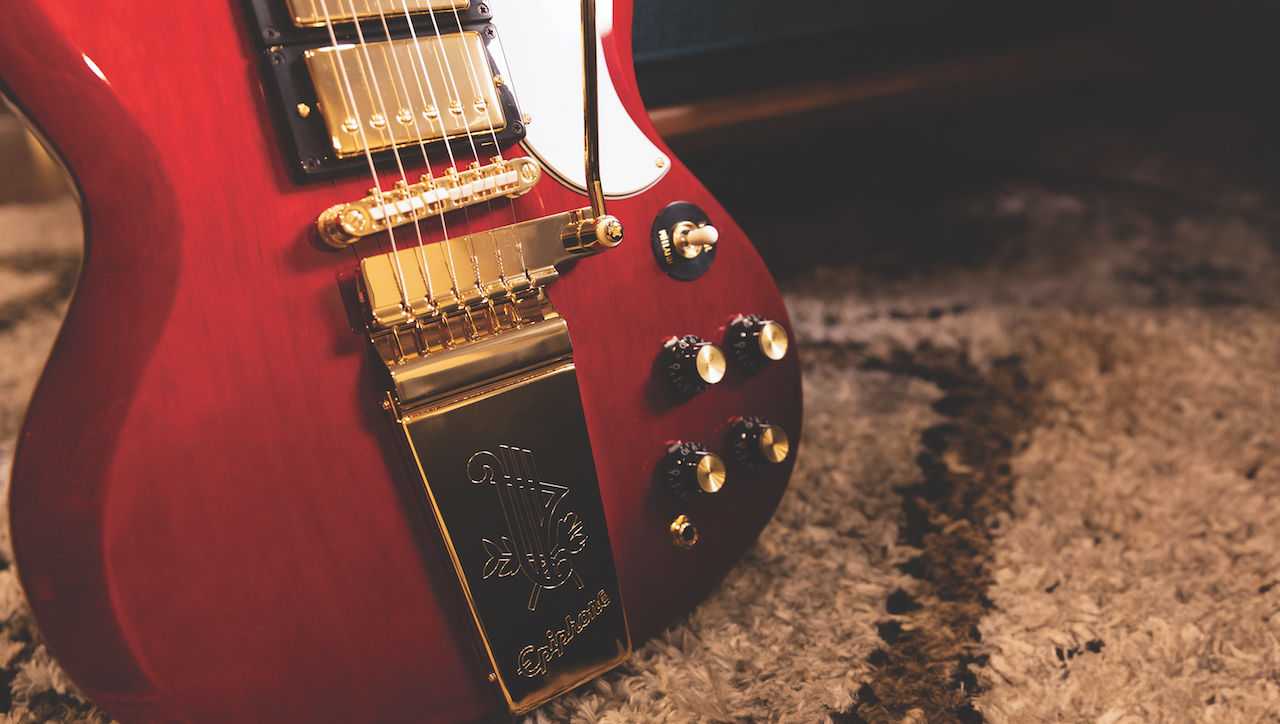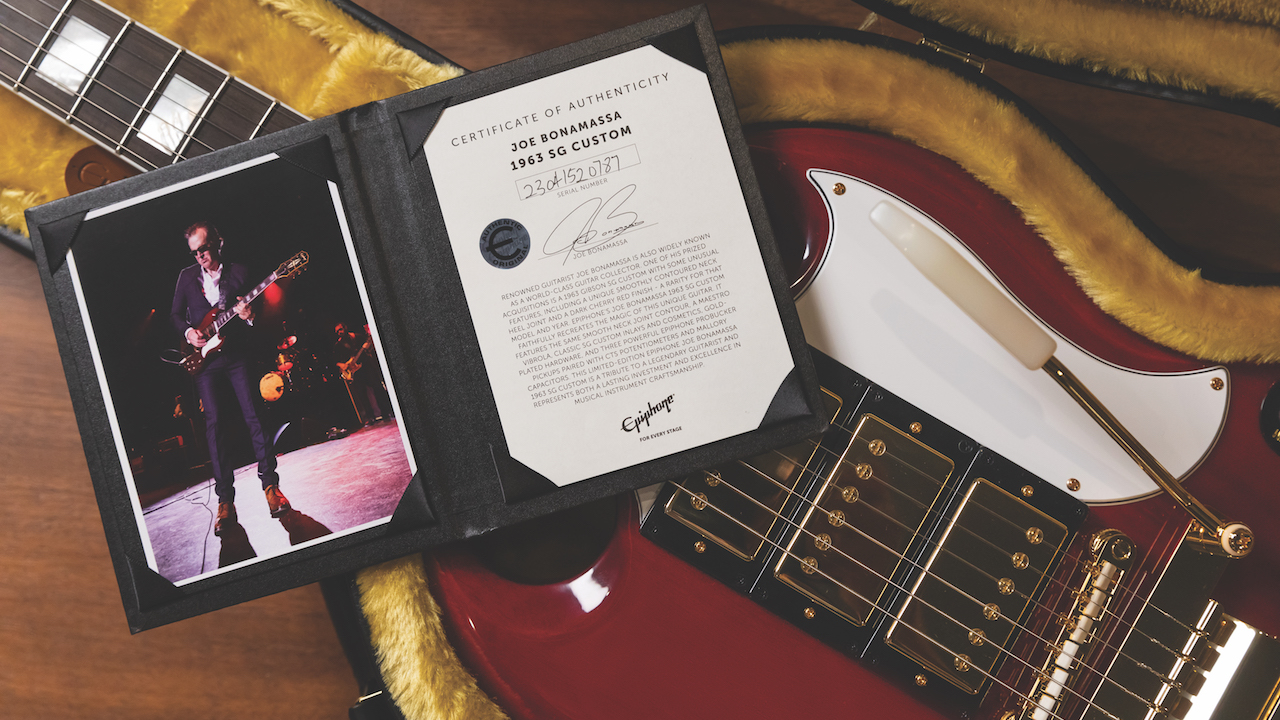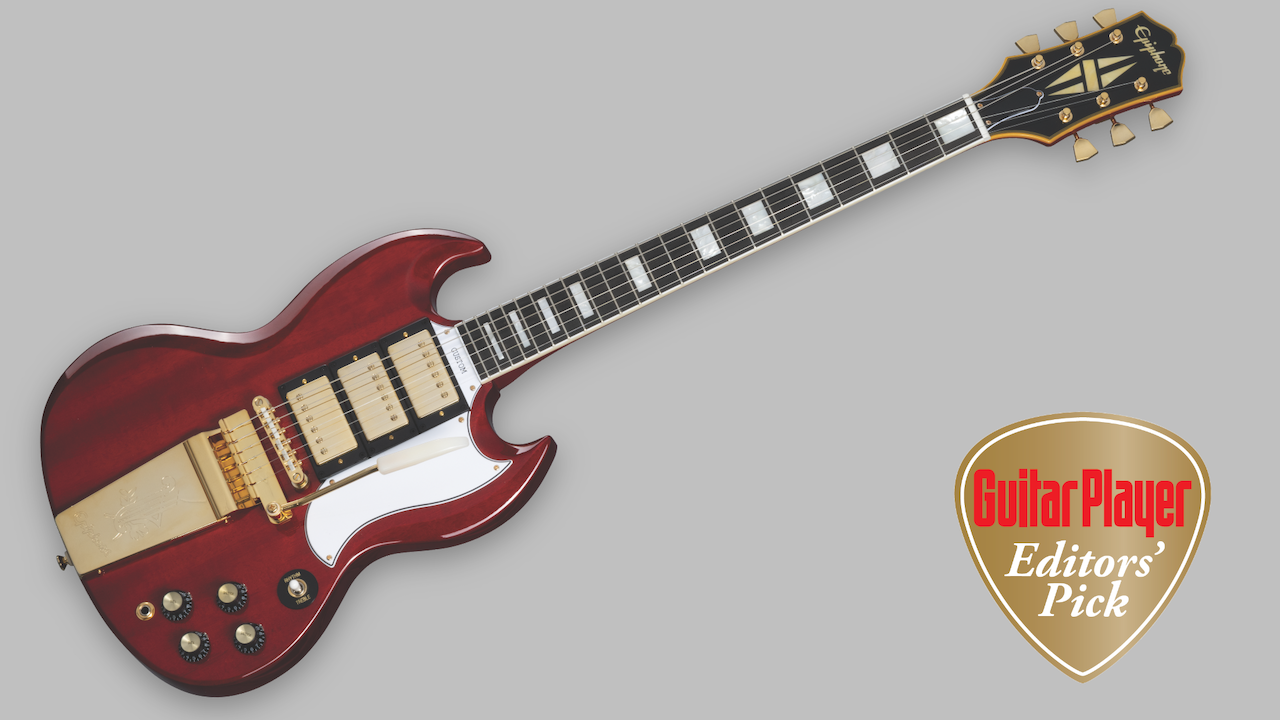GuitarPlayer Verdict
Epiphone’s Joe Bonamassa 1963 SG Custom is a great guitar that plays and sounds wonderful and looks like a million bucks. Tones are full ”with a cool twanginess” and it richly deserves an Editors' Pick Award
Pros
- +
Impressive tone, playability and build quality
Cons
- -
None
You can trust Guitar Player.
Epiphone’s latest limited-edition release focuses on a particular 1963 Gibson SG Custom that was special-ordered and obviously treasured by its original owner and is now part of Joe Bonamassa’s collection of prized vintage guitars.
Finished in Dark Cherry Red to match the rare color worn by the original guitar, the JB 1963 SG Custom features a mahogany body and a glued-in neck that’s carved in a SlimTaper C profile that melds into a smoothly contoured heel unique to this guitar.
As such, the playing feel is very comfortable and bending strings is glassy smooth, courtesy of an ebony fingerboard with 22 medium-jumbo frets that offer even crowns, a silky polish and nicely beveled tips.
A white Graph Tech nut with rounded corners enhances it all and helps make the guitar inspiring to pick up and play. The SG Custom was a class act in 1963, and Epiphone’s version is every bit as appealing.

The attention to detail is impressive, as evidenced by the flawless multi-ply binding and split-diamond mother-of-pearl inlay on the headstock, and by the single-ply binding around the fretboard, which has mother-of-pearl block inlays that are set without a trace of epoxy visible.
Other details include a white three-ply pickguard and a plastic “Custom” badge between the neck pickup and the end of the fretboard.
A plush-lined hardshell case and a booklet with a certificate of authenticity sporting Bonamassa’s signature are included.
All the latest guitar news, interviews, lessons, reviews, deals and more, direct to your inbox!
The gold-plated hardware consists of Kluson Waffleback tuners, a LockTone Tune-o-matic bridge with nylon saddles, and an engraved Maestro Vibrola tailpiece with an arm that rides in a nylon bushing and can fold out of the way when not being used.

The action of the unit is smooth and positive, and it didn’t knock the guitar excessively out of tune when used to its limits. The long tailpiece likely contributes to the SG Custom’s piano-like sustain too, and the guitar sounds lively and resonant when played acoustically.
In the electronics department, Epiphone ProBucker 2 pickups with alnico poles are fitted in the neck and middle positions, along with a ProBucker 3 at the bridge. A three-way toggle switch selects neck, middle-plusbridge and bridge, and it’s noteworthy that the dual-pickup combination is wired in-phase, unlike most SG Customs and Black Beauty Les Pauls, according to Bonamassa.
Far from sounding nasal, the tones are full and have a cool twanginess that’s very usable since you’re able to blend and EQ things to your heart’s content with the dual volume and tone controls.

The neck and bridge pickups offer everything from rich, clean jazzy sounds to meaty rock tones when revved up with distortion from pedals or pushed straight into an amp for classic PAF-style grind that’s controllable from the guitar for clean and dirty tones.
The CTS pots and Mallory caps used in the circuit certainly contribute to the guitar’s sound and the fact that it doesn’t lose crispness and definition when you turn down, or get muddy when you back off the tone knobs.
Epiphone’s Joe Bonamassa 1963 SG Custom is a great guitar that plays and sounds wonderful and looks like a million bucks. An obvious choice for anyone who’s priced out of the market for a vintage Gibson, it nails all the points that made the top-shelf SG of the time such an amazing guitar, and it is well deserving of an Editors’ Pick Award.
Specifications
- NUT Graph Tech, 1.692” wide
- NECK Mahogany, SlimTaper C profile
- FRETBOARD Ebony, 24 3/4” scale, 12” radius
- FRETS 22 medium jumbo
- TUNERS Kluson Waffleback
- BODY Mahogany
- BRIDGE LockTone Tune-o-matic with nylon saddles, Maestro Vibrola tailpiece
- PICKUPS Epiphone ProBucker 2 (neck and middle) ProBucker 3 (bridge)
- CONTROLS Two volume, two tone, three-way pickup switch
- EXTRAS CTS potentiometers, Mallory caps, Switchcraft pickup selector and output jack. Hard case with plush goldenrod interior and “Nerdville” graphics. Joe Bonamassa certificate of authenticity
- FACTORY STRINGS Gibson, .010–.046
- WEIGHT 7.94 lbs (as tested)
- BUILT China
For more information visit Epiphone

Art Thompson is Senior Editor of Guitar Player magazine. He has authored stories with numerous guitar greats including B.B. King, Prince and Scotty Moore and interviewed gear innovators such as Paul Reed Smith, Randall Smith and Gary Kramer. He also wrote the first book on vintage effects pedals, Stompbox. Art's busy performance schedule with three stylistically diverse groups provides ample opportunity to test-drive new guitars, amps and effects, many of which are featured in the pages of GP.

